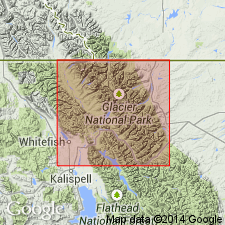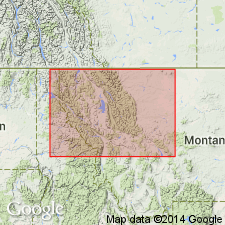
- Usage in publication:
-
- Hole-in-the-Wall member
- Modifications:
-
- Original reference
- Dominant lithology:
-
- Argillite
- Quartzite
- Limestone
- AAPG geologic province:
-
- Northern Rocky Mountain region
Summary:
Pg. 670-679. Hole-in-the-Wall member of Boulder Pass formation. Basal member of the Boulder Pass formation of the Belt series. Included in a generalized composite section of Lewis and Clark Ranges, south of Ahern Pass, Glacier National Park, Montana (Northern Rocky Mountain region), and in the Waterton Lakes National Park, Alberta, Canada. Is 391 to 440 feet thick. Composed of (descending): (1) metargillate, medium-bedded, finely banded, green, with large ripple marks in upper part, and fossil algae COLLENIA UNDOSA found locally near base, 16 feet; (2) metargillate, quartzite, and minor conglomerate beds, main mass being of red to buff sandy metargillates, mud-cracked, ripple-marked, and in spots cross-bedded, well exposed on slope above Granite Park chalet, 300 to 350 feet; (3) argillite, green to buff, finely banded, grading down into gray-buff argillaceous limestone, mud-cracked and ripple-marked, 75 feet. Overlies Granite Park member (new) of Siyeh formation and underlies Purcell lava of Belt series. Age is Proterozoic (Algonkian).
Derivation of name not stated but probably named from Hole-in-the-Wall Falls, Glacier National Park, Flathead Co., northwestern MT.
Source: US geologic names lexicon (USGS Bull. 896, p. 969); supplemental information from GNU records (USGS DDS-6; Denver GNULEX).

- Usage in publication:
-
- Hole-in-the-Wall member
- Modifications:
-
- Not used
Summary:
Is the same as the Spokane formation of the Piegan group (new) of the Belt series of this report. Neither Hole-in-the-Wall member nor Boulder Pass formation, to which it was assigned as the basal member, are used in this report.
Source: GNU records (USGS DDS-6; Denver GNULEX).
For more information, please contact Nancy Stamm, Geologic Names Committee Secretary.
Asterisk (*) indicates published by U.S. Geological Survey authors.
"No current usage" (†) implies that a name has been abandoned or has fallen into disuse. Former usage and, if known, replacement name given in parentheses ( ).
Slash (/) indicates name conflicts with nomenclatural guidelines (CSN, 1933; ACSN, 1961, 1970; NACSN, 1983, 2005, 2021). May be explained within brackets ([ ]).

